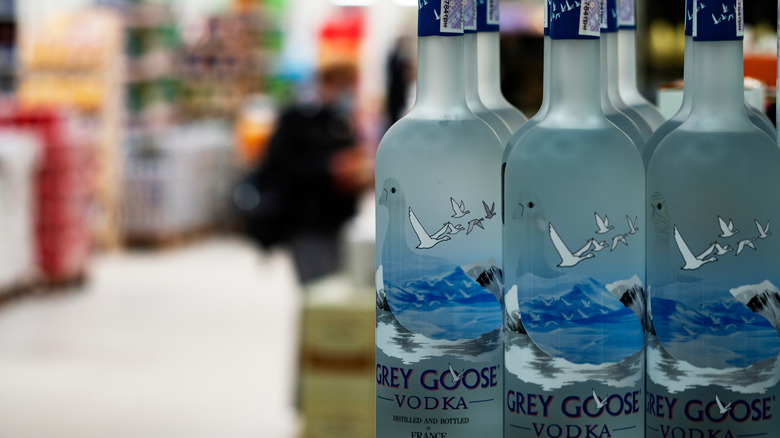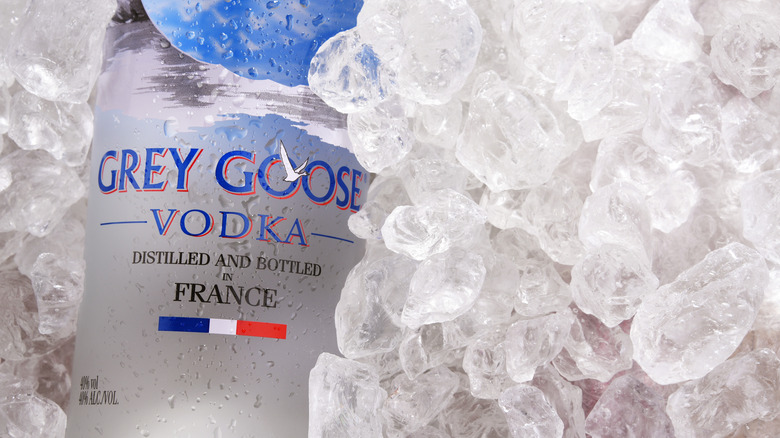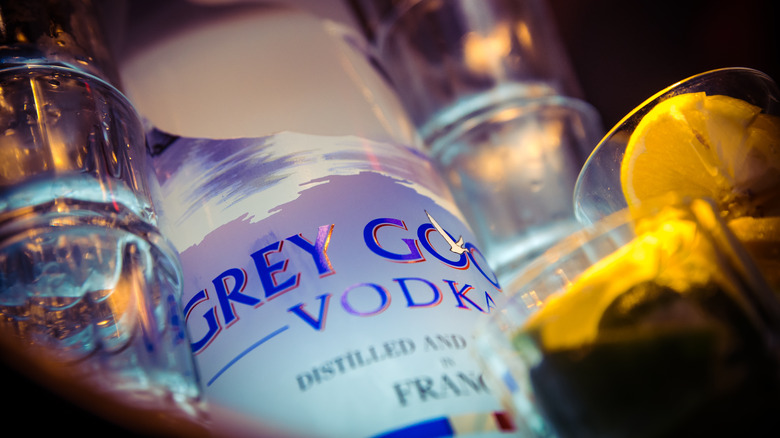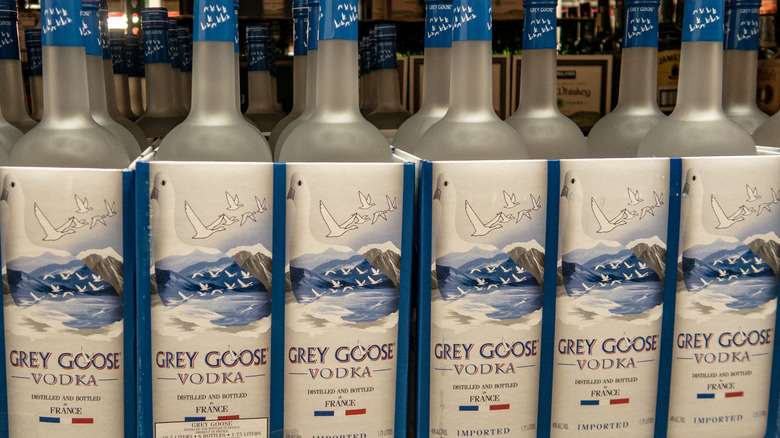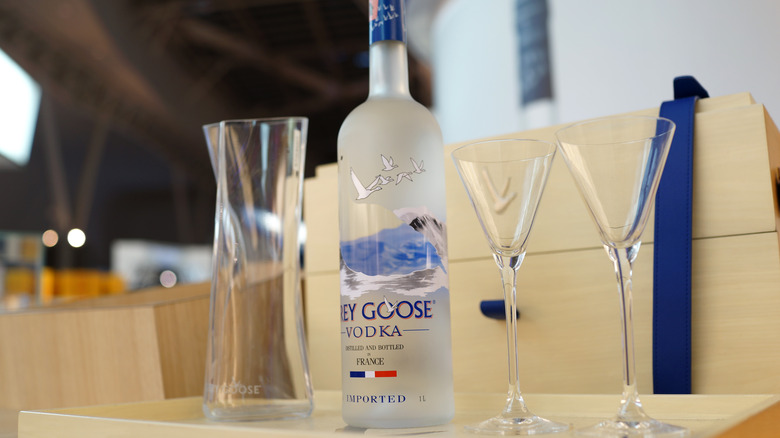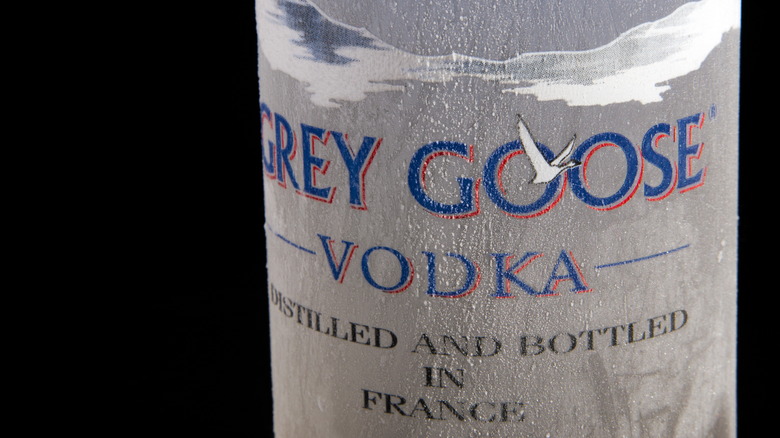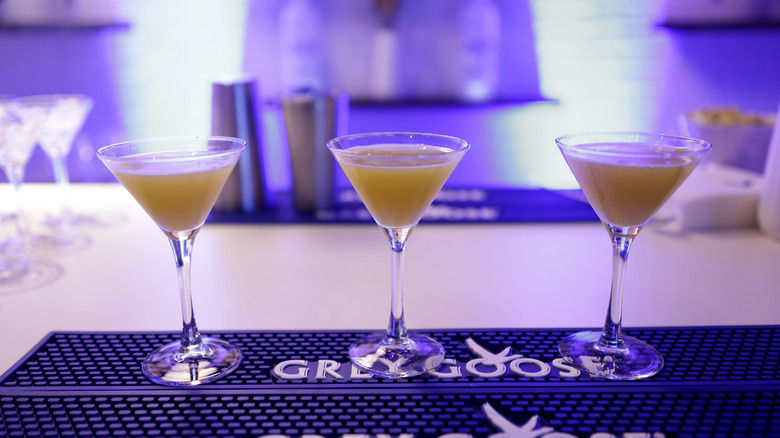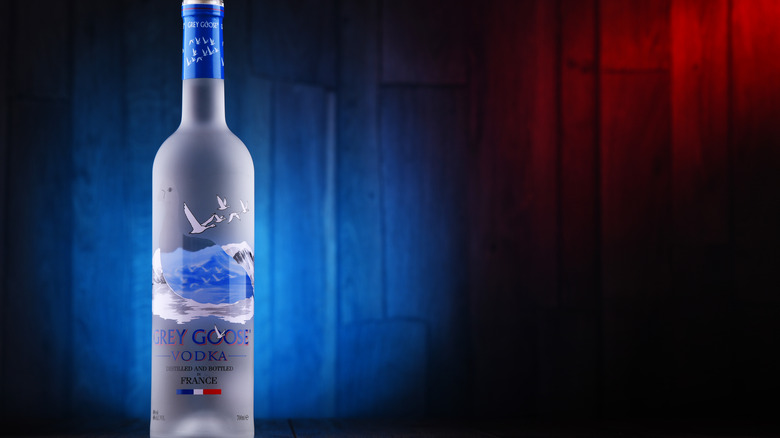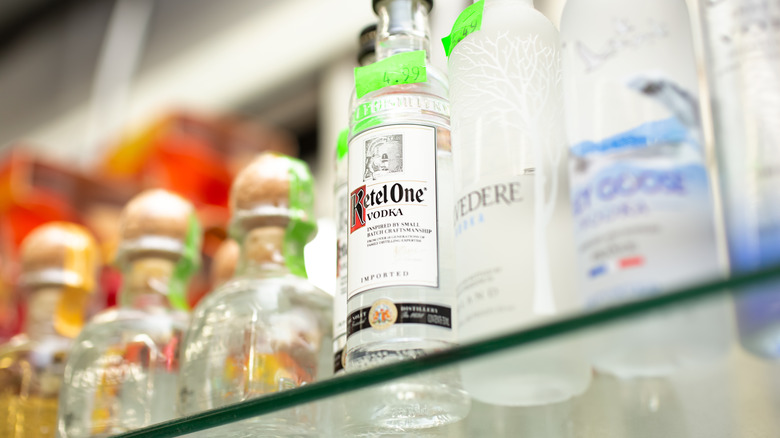Grey Goose Vodka: The Ultimate Bottle Guide
A picture of class isn't complete without Grey Goose vodka. Grey Goose is widely regarded as the genesis of luxury vodka and has enjoyed a longtime residency in A-list celebrity social circles (via PopSugar). But how much is really known about this liquor other than its alliterative name and top-tier price tag? Does elite vodka really stand out from competitors, or is the top shelf of vodka a myth?
Grey Goose vodka is about as French as it gets. Its made from two ingredients: single-origin soft winter wheat from Picardy, and spring water from Gensac-La-Pallue. At 80 proof (or 40% alcohol by volume), Master of Malt describes the vodka as clean and peppery on the palate with hints of wheat. However, while this liquor retailer appears to have given Grey Goose a stamp of approval — describing it as the "one of the creamiest vodkas we've ever tasted" — others are not so keen on it. Sprits Review dubbed Grey Goose a liquor based largely on superficial imagery, chosen mostly as a status symbol rather than for its taste. They even labeled it "the Paris Hilton of vodka."
Whether you're a fan or a skeptic, there's plenty to learn about Grey Goose's history, brand, and best uses before making the investment to add it to your liquor cabinet.
It was a pioneer in the super-premium vodka market
Grey Goose is the brainchild of spirits entrepreneur Sidney Frank, who'd already found success in the alcohol industry with his brand Jägermeister. In the 1990s, there was little competition to Russian vodka beside the Swedish vodka, Absolut, so Frank wanted to introduce a classy competitor from a new region with a reputation for haute goods and luxury wining and dining — France. He could have brought his envisioned drink head-to-head with lone lux vodka Absolut, but instead decided the Goose brand should soar higher and dubbed it an elite "super-premium" vodka.
The Grey Goose brand swooped onto the market in 1997 for roughly $30 per bottle, pricier than the $17 price tag for the comparative Absolut (via Spencer Brenneman). Frank then needed to establish his high-end brand in high-end crowds; the vodka was carefully name-dropped on the hit show Sex & the City, where the characters ordered it in the hottest NYC bars. Grey Goose was strategically donated to elite charity events. Luxury vodka was an emerging phenomenon in America, and consumers were flocking to the brand in droves. By 2004, Frank's brand was selling 1.5 million cases per year, according to Spencer Brenneman.
Four years later, in 2008, the Grey Goose name was known wide and far in luxury circles, and Frank sold his brand to Bacardi for $2 billion. Even with the change in hands, the sales continued to rise, with nearly 4 million cases sold in 2016.
The bottles are washed with Grey Goose
It's no secret that Grey Goose prides itself on its image. Another boast of the brand is its purity. According to Grey Goose, every drop of its vodka can be traced from the wheat to the bottle. True to this standard, the inside of each and every Grey Goose bottle is washed in Grey Goose vodka, "so it's the only liquid ever touching the bottle," the brand notes on its site. The corks are also softened in the vodka before being used to seal up the bottles.
While this purity is simply an added bonus to the luxury of Grey Goose, it provides reassurance to others. Because the vodka is made with single-origin wheat and the bottle sees no cross-contamination from other liquids, those with diet restrictions can take comfort in knowing that this brand is gluten-free, and vodka snobs can be assured that their spirits aren't watered down.
Grey Goose was a brand before it was vodka
Grey Goose founder Sidney Frank was eager to create a luxury brand of vodka, so eager that he woke up his right-hand man early one morning in an inspired frenzy with his newfound idea for the Grey Goose name, according to New York Magazine. There was just one small problem — at that moment in 1996, Grey Goose was no more than its moniker; Frank had no distillery, no bottle design, and no vodka recipe.
Frank putting the horse before the carriage is a testament to how important the new brand's image was to him. The market vision came first, and the marketable product followed. Grey Goose was, after all, simultaneously defining and inventing "super-premium vodka." From the moment Frank concocted the name of his latest spirit, carefully strategic branding was what lifted the vodka to success. Frank and his company were so strategic in constructing the Grey Goose image that they only used the colors of the French flag on its bottle, according to AdWeek. They also shipped the bottles in wooden crates as opposed to the cardboard used by competitors (via New York Magazine.
All of the world's Grey Goose is made by less than 20 people
Mass production is the antithesis of luxury, so it makes sense that the La Vallee de l'Oise distillery where Grey Goose is made is run by a mere 17 people, according to a Serious Eats writer who visited the location in 2020.
This small bunch of employees is responsible for the entire on-site distilling operation, which utilizes a series of custom-designed machinery for Grey Goose's fermentation and filtering (via Difford's Guide). The employees first quality-check the 25-ton loads of wheat that arrive at the facility. They then mill the wheat into flour, liquify, saccharify, and ferment it. Finally, the product goes through Grey Goose's own meticulous five-stage distillation process.
Perhaps most impressive is the brand's oversight of its product throughout the process; according to Grey Goose, each batch of the vodka undergoes 550 total quality checks, "a mix of actual human tastings and technical checks," from start to finish. Francois Thibault, a French cellar master who has carefully overseen Grey Goose production since it was founded, has taste-tested every round.
What does Grey Goose taste like?
Whether or not the taste of Grey Goose is worth raving over depends on who you ask. Enthusiasts of the extravagant vodka will describe it as very smooth with minimal burn and even creamy, according to Master of Malt. Countless consumers give the brand five stars for its smoothness (via Influenster). Grey Goose itself markets its taste as "the richness of almond with apple and citrus, alongside a hint of pepper and anise."
However, many other reviewers have not been so kind. This luxury brand was outperformed by the Costco-brand French vodka, which is one-third of Grey Goose's price, in blind taste tests (via Business Insider). Back in 2005, The New York Times taste testers tried top-shelf vodkas at the height of the super-premium vodka season, and the winner was an unexpected, affordable brand — Smirnoff. Grey Goose didn't even hold a candle to the underdog, not making the top 10 and deemed lacking balance and having "more than a touch of sweetness."
Spirits Review did a thorough review of the vodka. Though the site noted that Grey Goose had touches of vanilla and a crystal-clear appearance with no sediment, it critiqued the spirit as being unremarkable outside of its superficial image, reminiscent of food-grade ethanol, and "at best a bland, cheap-tasting vodka."
So is Grey Goose a price-bloated fashion vodka or the Cadillac of spirits? Ultimately, it seems up to each taster to decide.
How is Grey Goose made?
The Grey Goose brand prides itself on being 100% French-made, from its wheat to its water to even the ink on the bottles (via Serious Eats). The vodka is made from scratch in France from start to finish, starting with soft winter wheat harvested in Picardy. The wheat, sourced from local farmers that have been growing for generations, is sown in the autumn and harvested the following summer, according to Grey Goose.
The wheat then arrives at the La Vallee de l'Oise distillery to be ground into flour, a process that repeats four times to create a fine powder. In a process called saccharification, the flour's starch is converted to glucose, which is needed for fermentation. The spirit is fermented and distilled once into a 96% ABV spirit; the five-step distillation process, designed by Grey Goose's maker, takes place in steel and copper columns and requires "constant monitoring of hundreds of variables," Grey Goose says.
That product is combined with water from Grey Goose's private well in Gensac-la-Pallue, in the Grande Champagne Cognac region. This is no ordinary H2O; it has filtered through limestone for centuries, is tapped on the very day it will be sent to the bottling plant, and is thoroughly filtered of mineral content before being added to the vodka.
The final step in Grey Goose's production is a single filtration through a cellulose and active carbon screen. After the light filtering, the vodka rests before being bottled.
How to drink Grey Goose
Whether you are a spirits purist or want to bury the taste of your alcohol with mixers, there's a way to drink Grey Goose for everyone. If you are brave enough to drink vodka straight, Grey Goose recommends doing so with this three-step process: look, smell, then taste. First, the manufacturer says you should look at your vodka; pour some in a clear glass and hold it up to the light. Notice its color, clarity, and "legs" — or how it clings to the glass when swirled around. Grey Goose then encourages you to explore the vodka's aromatics by swirling the liquid and gently inhaling. Finally, slowly introduce the straight spirit to your palate by sipping a tiny amount, swirling it in your mouth, then spitting it out. Take another drink immediately after priming your palate to catch all of the vodka's subtle tastes.
Note that Grey Goose is available in the traditional version as well as its flavored line and essences line. The flavored options include La Poire (pear), L'Orange (orange), and Le Citron (lemon), and Grey Goose's essences include strawberry and lemongrass, watermelon and basil, and white peach and rosemary.
If you're one of the many that prefer vodka to have some support in a cocktail, there are plenty of classic and innovative vodka drink recipes to explore, such as the espresso martini, Moscow mule, lemon drop, Bloody Mary, or cosmopolitan.
Why is Grey Goose so expensive?
If you ask Grey Goose why it asks over $50 for a 1.75 liter bottle, the brand would tell you that it's all to support the finest ingredients and single-origin production that its vodka is known for. After all, soft winter wheat, which Grey Goose is made of, is referred to as "blé panifiable supérieur" by the French, meaning the best wheat for the finest French pastries and bread.
But others say that the brand's poor performance in blind taste tests is a clear indicator that the only reason people drink Grey Goose vodka is to convey an image of high-class and exclusivity. Clearly, this strategy has brought Grey Goose at least some success, earning it a cameo at plenty of celebrity events and parties, such as the New York Fashion Week party last September, where Kehlani was one of many celebs to pose with a bottle of Goose (via Paper Magazine).
Grey Goose vs. Ketel One
Both Grey Goose and Ketel One have loyal fanbases. Stat-for-stat, which is the better drink? Ketel One also uses premium winter wheat for its spirit — and that wheat is one of Grey Goose's major selling points. However, Grey Goose's wheat is French, and Ketel One's is Dutch. Both vodkas are 80 proof, but 750-milliliter bottles of Ketel One currently sell for roughly $23, while the same amount of Grey Goose will run around $30.
According to Liquor Laboratory, Ketel One vodka undergoes a more complex production process, bringing a sweet mintiness to its flavor profile. Meanwhile, Grey Goose is bitter and biting on the palate. Ketel one is light and citrusy, while Grey Goose is more spicy and peppery.
While vodka is generally less likely to leave you with an unpleasant hangover than darker liquors, Grey Goose is said to be more manageable the morning after a night of drinking than Ketel One, thanks to its filtering and raw ingredients (via Liquor Laboratory). The two spirits' water sources are also different; Grey Goose's water is filtered through limestone, while Ketel One's is filtered through charcoal.
